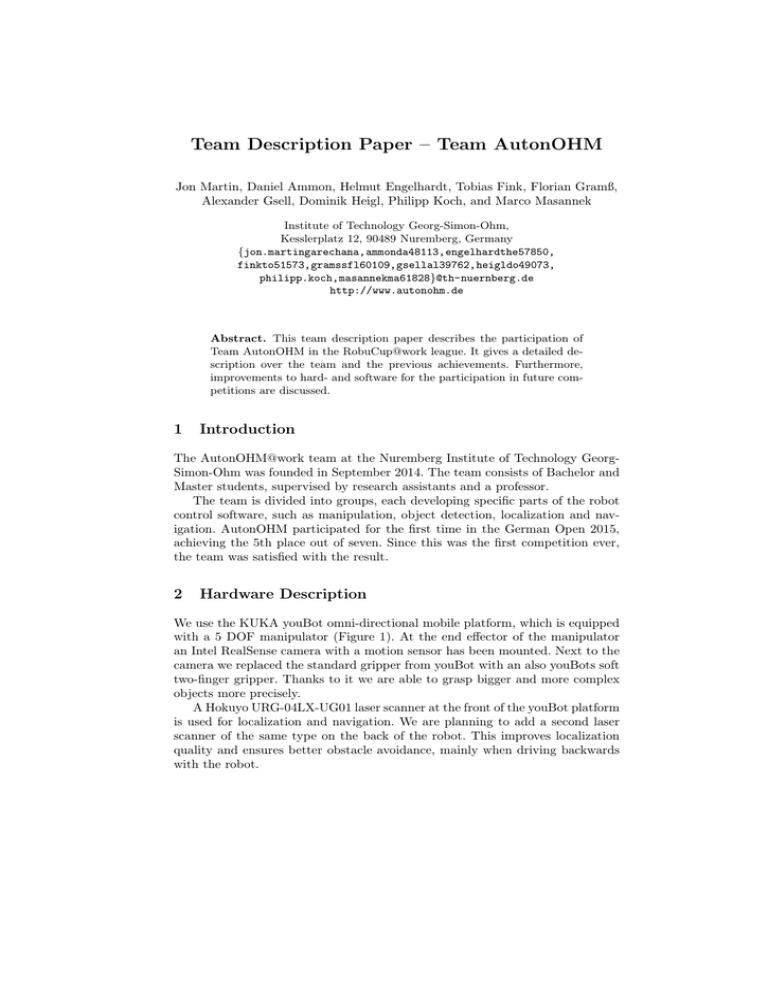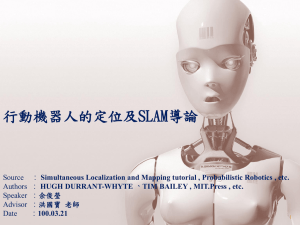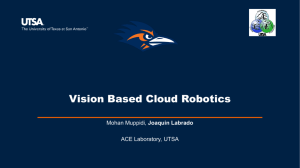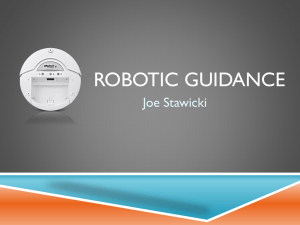AutonOHM - RoboCup
advertisement

Team Description Paper – Team AutonOHM
Jon Martin, Daniel Ammon, Helmut Engelhardt, Tobias Fink, Florian Gramß,
Alexander Gsell, Dominik Heigl, Philipp Koch, and Marco Masannek
Institute of Technology Georg-Simon-Ohm,
Kesslerplatz 12, 90489 Nuremberg, Germany
{jon.martingarechana,ammonda48113,engelhardthe57850,
finkto51573,gramssfl60109,gsellal39762,heigldo49073,
philipp.koch,masannekma61828}@th-nuernberg.de
http://www.autonohm.de
Abstract. This team description paper describes the participation of
Team AutonOHM in the RobuCup@work league. It gives a detailed description over the team and the previous achievements. Furthermore,
improvements to hard- and software for the participation in future competitions are discussed.
1
Introduction
The AutonOHM@work team at the Nuremberg Institute of Technology GeorgSimon-Ohm was founded in September 2014. The team consists of Bachelor and
Master students, supervised by research assistants and a professor.
The team is divided into groups, each developing specific parts of the robot
control software, such as manipulation, object detection, localization and navigation. AutonOHM participated for the first time in the German Open 2015,
achieving the 5th place out of seven. Since this was the first competition ever,
the team was satisfied with the result.
2
Hardware Description
We use the KUKA youBot omni-directional mobile platform, which is equipped
with a 5 DOF manipulator (Figure 1). At the end effector of the manipulator
an Intel RealSense camera with a motion sensor has been mounted. Next to the
camera we replaced the standard gripper from youBot with an also youBots soft
two-finger gripper. Thanks to it we are able to grasp bigger and more complex
objects more precisely.
A Hokuyo URG-04LX-UG01 laser scanner at the front of the youBot platform
is used for localization and navigation. We are planning to add a second laser
scanner of the same type on the back of the robot. This improves localization
quality and ensures better obstacle avoidance, mainly when driving backwards
with the robot.
2
Team Description Paper – Team AutonOHM
Last year we used the internal computer, together with an external ASUS
Mini PC (4 GB RAM, Intel Core i3). We used the internal computer in the
youBot to start-up the motors and also for the SLAM. This was a huge error
because we added an enormous data transfer between the two computers, what
slowed down the complete system. To avoid the communication problems and
latency between them both, we decided to run everything, except the motor
drivers, on the external PC. We also replace the slow i3 for a more powerful CPU
Intel Core i7-4790K, 4x 4.00 GHz. Table 1 shows our new hardware specifications.
For connecting the two PCs we use a router mounted on the back of youBot.
With external machines we can connect to the routers network and communicate
with both PCs on the youBot.
We also added an Inertial Measurement Unit (IMU) to gather information
about the heading of the platform. On the IMU runs a fusion algorithm which
provides the orientation of the platform as quaternion or Euler angles.
Fig. 1. KUKA youBot Plattform
Tab. 1. Hardware Specifications
PC 1
CPU
Intel i7-4790
RAM
16 GB DDR3
Storage
SSD 128 GB
OS
Ubuntu 14.04
PC 2
CPU
Intel Atom D510
RAM
2 GB DDR2
Storage
SSD 32 GB
OS
Lubuntu 14.04
Grasp
Type
soft, two-finger
Stroke
20 mm
Lidar
Type
Hokuyo URG-04LX
Range
5.6 m
Resolution
0.352 deg
Router
Type
Edimax 2.4/5 GHz
IMU
Type
BNO055 Bosch
DOF
9
Rate
30 Hz (ROS)
Team Description Paper – Team AutonOHM
3
3
Software
The software architecture is based on the Robot Operating System ROS. The
system runs with Ubuntu 14.04 and ROS Indigo installed. The ROS communication infrastructure is used to communicate and pass information between the
nodes, as for example camera data or execution orders for the 5 DOF manipulator.
Several software tools are needed for image processing and controlling the
system. In the following, software used for developing or to control the robot in
the competition is listed.
Unless otherwise stated, the following software is available from the official
ubuntu software repositories.
cgdb For online-debugging we use cgdb. It is a command line interface to the
GNU debugger software.
dd We create images from the hard discs to recover from a hard disc failure at
the contest.
eclipse For all C++ development we use eclipse IDE.
chrony Using ROS on multible machines requires time synchronisation between
them. We use chrony for synchronizing the time on both PCs.
git Our software is maintained via git version control system. Git enables us
working simultaneously on our software tree.
htop To watch active processes and CPU-Load we use htop.
openssh-server It provides access to the robot via ssh protocol.
QtSixA We steer our youBot with a Playstation 3 joystick. We need this software to connect the joystick to the PC via bluetooth.1
screen Each time we access the platform through ssh we enter a screen session.
With this software we are able to open multiple command line sessions, set
a split screen and reconnect to a session if network connection drops.
stress We used stress to test our thermal management. It immediately can
switch all CPU load to 100%, so it simulates worst case CPU load.
vim For developing over ssh connection on the robots PCs, or editing ROSLaunchfiles we use vim text editor with several plugins.
OpenCV OpenCV has been used to build an 2D image processing node. Some
useful functions and algorithms have been included into our object recognition.2
Additionally we use the following ROS3 packages:
amcl For localization problem we eventually use amcl package. It implements
a particle filter algorithm. (see chapter 6)
map-server Storing and loading occupancy-grid-maps is done by the mapserver package.
1
2
3
http://qtsixa.sourceforge.net/
http://opencv.org/
http://wiki.ros.org/
4
Team Description Paper – Team AutonOHM
navigation For global/local path planning, path regulation and obstacle detection/avoidance we plan to use the navigation stack from ROS.
robot-pose-ekf For fusing the data from the IMU and the wheel encoders we
use the robot-pose-ekf. It is an implementation of an extended Kalman filter
algorithm. It enables us to mix the two systems and improves the odometry
data from the wheel encoders.
stdr-simulator We use it for simulating everything except the actuator. Every
team member can test software through simulation in STDR, before testing
with the robot in the reality.
youbot-driver Our youBot platform is controlled with this package.
Finally our own software packages:
ohm tsd slam For recording a map from the environment we use our own
SLAM algorithm. (see chapter 5)
particle-filter For localization problem we eventually use our own particle filter
instead of amcl package. (see chapter 6)
statemachine To control the robot we have implemented a statemachine algorithm with the statemachine framework from our laboratory. (see chapter 7)
4
Image Processing
To grab an object reliably, we needed a stable image processing. Our current
system uses a 2D camera. Important criteria for the 2D image processing:
1. speed
2. stability
3. low use of cpu resources
To fulfill these criteria, the OpenCV4 library has been used. The incoming
image gets converted into a gray-scale image. Some times it is necessary to apply
a Median or Gaussian filter afterwards, to get better results. Finally the edges
will be extracted through the canny edge detector. The received binary edges
image is now ready to be processed.
To recognize a certain object, a complete contour needs to be defined. Complete contours get identified through the findContours function from OpenCV.
The saved contours get sorted by given attributes like number of corners, area
size or diagonal length.
If an object has been identified, the position of the object is calculated.
However, as only a 2D sensor is used, the distance between object and camera
has to be known. With this information, the 3D coordinates of the object are
estimated and can be used for instance to manipulate.
4
http://opencv.org/
Team Description Paper – Team AutonOHM
5
5
Mapping
The arena at RoboCup@work is virtually unchanged during the competition.
Therefore, a SLAM approach is unnecessary. Since industrial production sites
have in general a static layout, this assumption is justified. However, a SLAM
algorithm is required to generate the initial map, or update the information to
add smaller changes.
The Autonohm RoboCup Rescue team deployed successfully a self developed SLAM approach, ohm tsd slam. The referring ROS package is based on
a 3D/2D reconstruction and localization framework which has been subject of
May et. al. [7]. Additional work by Koch et. al. [6], aimed at multi-source-SLAM
and loop closing capabilities.
Fig. 2. Mapping Example. Image depicts the resulting map of two cooperating robots.
The red and green lines illustrate the estimated trajectory of both units. This map
shows an additional feature of ohm-tsd-slam, the approach is able to map comparably
large areas as the reconstructed map had an edge length of 122 m. Source: Koch et.
al.[6].
In order to build maps of the RoboCup@work arena, only data of a 2D
LIDAR is required. In an iteration, the SLAM framework first reconstructs an
artificial laser scan out of the map from the last known robot pose, using a
raycasting implementation.
6
Team Description Paper – Team AutonOHM
In the second step, a scan matching algorithm based on the Iterative Closest Points (ICP) algorithm (Chen and Medioni [2], Besl et. al. [1], Zhang [9]
and Random Sample Consensus (RANSAC) algorithm (Fischler et. al. [5])) estimates the transformation between the reconstructed laser data and the current
scan. This pose change is applied to the last known pose and results in the new
localization of the robot.
The map is being updated from the new acquired robot pose and converted
in a ROS compatible data format (occupancy grid) in the last step. This step
is necessary as the ohm tsd slam package uses an abstract representation based
on Signed Distance Functions (SDF) (Curless et. al. [3]), which is incompatible
to standard ROS packages. Figure 2 depicts a map generated by ohm tsd slam.
More information and a git repository regarding the 2D single or multi-SLAM
ROS package ohm tsd slam can be found on the referring ROS Wiki page5 .
6
Localization
Currently, the team considers three different strategies concerning the localization problem. The first one is using a self developed particle filter algorithm.
The second is to use the amcl package from ROS. And the third strategy is to
use the self developed ohm tsd slam algorithm mentioned in chapter 5. In the
future, all strategies will be tested and compared.
6.1
Particle-Filter (TH-Nuernberg)
The team works currently on an own particle filter algorithm. Its functionality
is close to amcl localization, [4] and [8].
6.2
Particle-Filter (ROS-AMCL)
The navigation stack from ROS-System includes a package called amcl (Adaptive Monte Carlo Localization). It provides a particle filter algorithm for robot
localization.
The compatibility of amcl algorithm and our SLAM approach has already
been tested. It is possible to record a map with ohm tsd slam and afterwards
localize and navigate in that map via amcl and navigation stack from ROS.
6.3
SLAM for Localization
It is possible to disable the mapping in the ohm tsd slam package, using a localize
only mode. In this mode, the software loads a previously recorded map, localizes
the robot using its sensor data but does not alter the map. The main weakness
of this approach compared to a particle filter is a possible wrong localization.
A particle filter is able to redetect a lost pose using global localization, the
ohm tsd slam package does not provide this feature.
5
http://wiki.ros.org/ohm tsd slam
Team Description Paper – Team AutonOHM
7
7
Mission Planning
For the main control of the system, a State Machine with singleton pattern design
is used. Every state is designed to be as small as possible. For the German Open
2015, we implemented three main states divided on smaller sub-states: move,
grasp and deliver (see figure 3).
On the initialization state, the robot receives the map and localizes itself on
it. A state Idle is entered after that which waits until a task is received from the
referee box. The complete task is divided into smaller subtasks and managed in
stateNext.
The first step is always driving to a specific position with a specific orientation. In this case, the path planner estimates a trajectory on the map. The
robot drives to the desired position by following the calculated waypoints. Once
the moving task is finished the state machine returns to StateNext, to process
the next task.
In case of grasping, the robot approaches the service area and the state
machine enters stateFindDesiredObject. After localizing this object, it is grasped
and stored on the back of the robot.
In case of delivering an object, the robot also moves into the service area,
picks the object from its back and delivers it to the service area.
The State Machine framework can be found on GitHub under our Laboratorys repository: autonohm/obviously.
Fig. 3. Structure of the Statemachine
8
Team Description Paper – Team AutonOHM
8
Object Manipulation
To grasp objects reliably an exact position from the object perception is needed.
The position of objects will be calculated based on information, received from
optical/infrared sensors (2D and 3D). After the calculation is finished the robot
will navigate to a pregrasp position. Once the base has reached the final position,
kinematics will lead the arm near the object. For precise gripping a 2D/3D
optical/infrared sensor has been attached to the end effector. In gripping stance
the arm-camera will be activated to measure the final gripping pose. Because
manipulation is an upcoming issue in our robotic institute, a self developed
inverse kinematic is deployed.
9
Reusability and Applicability
Every time we develop software, we try to link the ROS system as late as possible. So we can ensure good reusability and applicability on other systems.
Additionally, most of the software is managed in standalone packages, which
eases integrating them into other systems. By adding code to our laboratory’s
library6 , which includes many standard solutions to robotic problems, rewriting
or copying of code is prevented and software maintenance is simplified.
10
Conclusion and Future Work
This paper describes the participation of team AutonOHM in the RobuCup@work
league. It provided detailed information of localization, autonomy, image processing and object manipulation.
In future work, 3D perception will be used for object localization. Moreover, the team plans on deploying self developed software for localization and
navigation to improve the robot autonomy.
Furthermore, it is planned to mount a second laser scanner facing backwards,
in order to improve localization quality. Moreover, the second sensor would allow
backwards driving as obstacles behind the robot can be detected as well.
6
https://github.com/autonohm/obviously
Team Description Paper – Team AutonOHM
9
References
1. P.J. Besl and Neil D. McKay. A method for registration of 3-d shapes. Pattern
Analysis and Machine Intelligence, IEEE Transactions on, 14(2):239–256, Feb 1992.
2. Y. Chen and G. Medioni. Object modeling by registration of multiple range images. In Robotics and Automation, 1991. Proceedings., 1991 IEEE International
Conference on, pages 2724–2729 vol.3, Apr 1991.
3. Brian Curless and Marc Levoy. A volumetric method for building complex models
from range images. In Proceedings of the 23rd Annual Conference on Computer
Graphics and Interactive Techniques, SIGGRAPH ’96, pages 303–312, New York,
NY, USA, 1996. ACM.
4. F. Dellaert, D. Fox, W. Burgard, and S. Thrun. Monte Carlo localization for mobile
robots. Proceedings 1999 IEEE International Conference on Robotics and Automation (Cat. No.99CH36288C), 2(May):1322–1328, 1999.
5. Martin A. Fischler and Robert C. Bolles. Random sample consensus: A paradigm
for model fitting with applications to image analysis and automated cartography.
Commun. ACM, 24(6):381–395, June 1981.
6. Philipp Koch, Stefan May, Michael Schmidpeter, Markus Kuhn, Christian Pfitzner,
Christian Merkl, Rainer Koch, Martin Fees, Jon Martin, and Andreas Nuchter.
Multi-robot Localization and Mapping Based on Signed Distance Functions. 2015
IEEE International Conference on Autonomous Robot Systems and Competitions,
pages 77–82, 2015.
7. Stefan May, Philipp Koch, Rainer Koch, Christian Merkl, Christian Pfitzner, and
Andreas Nüchter. A Generalized 2D and 3D Multi-Sensor Data Integration Approach based on Signed Distance Functions for Multi-Modal Robotic Mapping. 19th
International Workshop on Vision, Modeling and Visualization, 2014.
8. S. Thrun, W. Burgard, and D. Fox. Probablistic Robotics. Massachusetts Institute
of Technology, 2006.
9. Zhengyou Zhang. Iterative point matching for registration of free-form curves and
surfaces. Int. J. Comput. Vision, 13(2):119–152, October 1994.




